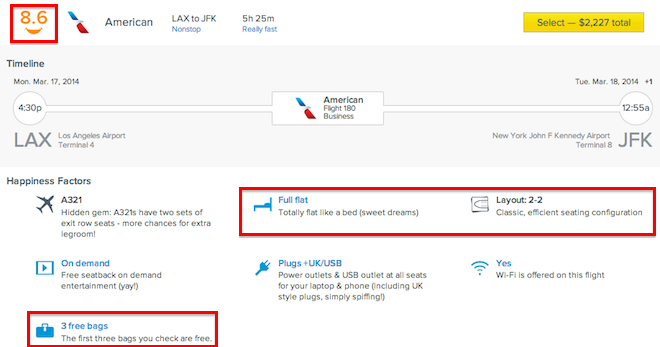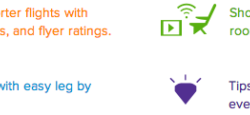I’ve written about Routehappy at least once before. It’s one of a few airline search engines that attempts to improve the user experience by adding information on in-flight amenities and user reviews in addition to traditional sorting criteria like price or the number of connections. Because while consumers do tend to be price sensitive, they aren’t immune to common sense when told a better flight is available for a few dollars more. (If it’s a lot more, well, nothing Routehappy can do about that…)
What I consider Routehappy’s defining feature is the Happiness Score — think of it as the inverse of Hipmunk’s Agony Index. Flights with more convenient arrival and departure times, fewer connections, in-flight entertainment, and better user reviews will receive higher scores. These scores are displayed alongside prices so you can quickly spot the difference between two otherwise similar fares.
In the example below, I did a search for a one-way ticket from Seattle to San Francisco on a Monday morning in March. You’ll notice the results are sorted by Happiness Score, from 8.8 down to 5.9 (and worse). Virgin America benefits from lots of in-flight features, but United suffers from missing WiFi, using regional jets, and adding connections. Virgin America has the best score, but you can also tell that Alaska Airlines provides several flights with scores almost as good and which cost $23 to $63 less.
The addition of user reviews to the more empirical benefits above are what I think really distinguish Happiness Scores from competitors’ measures. Very few services let you rate individual flights and carriers and match that information with search results. You can even compare entire carriers and read other users’ reviews. United Airlines and American Airlines, for example, are merely “Ordinary.” Southwest Airlines has a good reputation and is, unsurprisingly, “Good.” But you guys know I like to promote Alaska Airlines, which can boast a “Very Good” rating on par with Singapore Airlines. (Obviously each sets different expectations, but they fulfill those expectations well.)
A lot of detailed “facts” go into Happiness Scores, as well, including baggage fees, seat pitch, and layout (2-5-2 vs. 3-4-3 on a Boeing 777, for example). As these features change between cabins, you may find different scores for economy class and first class on the same flight. A business traveler whose employer authorizes first class tickets may use these scores to choose one preferred carrier for work and another when traveling in economy class on vacation. Below is an example of the Happiness Score and features of an economy class ticket from LAX to JFK on American Airlines’ new A321T.
And now see how the results update when you change to a business class fare. The score goes up, and features like free checked baggage, a lie-flat seat, and a new cabin configuration are updated.
Finally, I want to touch on a rather interesting feature: the ability to display and sort all nonstop destinations from a particular city. It’s great when you want to plan a trip but aren’t entirely sure where you want to go. Here are the results for Seattle, after I’ve selected only destinations with a first class cabin (I want the opportunity for an upgrade), in-flight WiFi, and in-seat power. You can even narrow it by geographic region or select dates!










